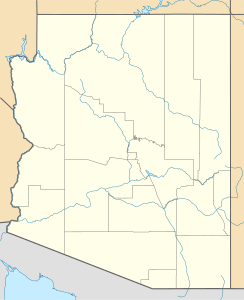Mount Graham
| Mount Graham | ||
|---|---|---|
|
Mount Graham of Safford seen |
||
| height | 3267 m | |
| location | Arizona , USA | |
| Mountains | Southeast Arizona Ranges | |
| Coordinates | 32 ° 42 ′ 7 ″ N , 109 ° 52 ′ 19 ″ W | |
|
|
||
The Mount Graham ( Dzil Nchaa Si An , "Big seated mountain" in the language of Apaches -Indianer) is a 3267 m high mountain in Graham County in southeastern Arizona .
In 1993 the observatory of the Vatican (it. Specola Vaticana ) opened its new observatory ( VATT ). The new building had become necessary because the light pollution at the previous locations no longer allows scientific work.
It was the first of three planned observatories.
A large telescope has been under construction there since 2004, the Large Binocular Telescope , in which, among others, five German research institutes are involved. The erection of this telescope is fiercely criticized and opposed by the native Apaches, who regard Mount Graham as a sacred mountain and the erection of artificial structures on the mountain as incompatible with the religious beliefs of the Apaches. Dzil Nchaa Si An is comparable to Mount Sinai in terms of its meaning in the Apache's religious imagination : Here the Apaches once received the “32 songs of life” from their creator god.
Mount Graham is a unique biotope and ecosystem on the American continent and is often compared to the Galápagos Islands . Some endangered animal species are native to the mountain, e.g. B. the Mount Graham red squirrel ( Tamiasciurus hudsonicus grahamensis , English Mount Graham Red Squirrel ). Although they are protected by US law, the federal government in Washington, DC , in cooperation with the US Congress and the University of Arizona , circumvented the relevant animal welfare laws through exemptions in order to allow the construction of the telescopes.
The red squirrel population has recovered significantly since the beginning of the astronomical use of the mountain, which was accompanied by the end of the previous hunting and camping operations.
Sacred mountain of the Apaches
Opponents of the telescope project criticize the fact that important laws (environmental protection, protection of endangered animal species, right to freedom of religion of the Indians) have been cleverly overridden or overridden by exceptions to make the construction possible.
From the beginning, the San Carlos Apaches fought against the construction of the telescopes. They have received support from other Native American tribes, inter-tribal Native American organizations, and numerous environmental protection organizations in the United States. In 1990 the Apache Survival Coalition (ASC) was founded by the Apache Ola Cassadora Davis to make the resistance more effective. There was also a second organization, “Apache for Cultural Preservation” (AFCP), launched by Wendsler Nosie and Ernest Victor Jr., two former members of the tribal council.
Numerous resolutions of the tribal council as well as a petition from the council of medicine men and women clearly oppose the telescope project; they reflect the opinion of the majority of the San Carlos Apaches. In connection with the protest against the telescopes on their sacred mountain, the Apaches even broke their principle that religious matters should not be discussed in public.
North American partners who were initially interested in the project, such as B. Harvard University, Michigan State University, University of Toronto and others have dropped out due to the great pressure from the resistance of the Apaches and environmentalists.
In November 1997, US President Clinton, with the help of his veto right, stopped funds amounting to 10 million dollars that had already been approved by Congress for astronomical projects. A large part of it was intended for the LBT. Clinton justified his veto, among other things, with the fact that the LBT would use techniques that z. B. already exist in an observatory in Hawaii. The Apache Tribal Council has received this news positively.
The Apache protest against the telescope project is also widely supported in Italy. In 1998, 83 members of the Italian parliament signed a motion to their government to co-finance the large binocular telescope only if a location other than Mount Graham was chosen.
In March 1999 the tribal council of the San Carlos Apache again appealed to the governments of Germany and Italy to withdraw from the financing of the observatory project on Mount Graham. In April 1999 Wendsler Nosie traveled to Germany and Italy to draw attention to the fact that traditional and religious concerns of the Apache are still ignored. He made it clear that the Apache's resistance is unbroken, that their goal - stopping the project and dismantling already completed systems - still exists. One of his main concerns in Germany was to meet parliamentarians and to sensitize them to the reasons for the resistance of the Apaches in order to open up possibilities of parliamentary support similar to Italy.
Since 1992, Wendsler Nosie, together with friends from AFCP and ASC, has been organizing an annual Sacred Run - a holy run - that leads from the San Carlos Reservation to the summit of Mount Graham. Members of other tribes and supporters from European countries take part in this run, which underlines the Apache protest against the telescope project.
Web links
Individual evidence
- ↑ Anka Krämer de Huerta, Places of Power. On the meaning and conception of sacred places among the Western Apaches. , LIT Verlag, bayreuther forum transit 12, 2011, ISBN 978-3-643-11109-8 .

